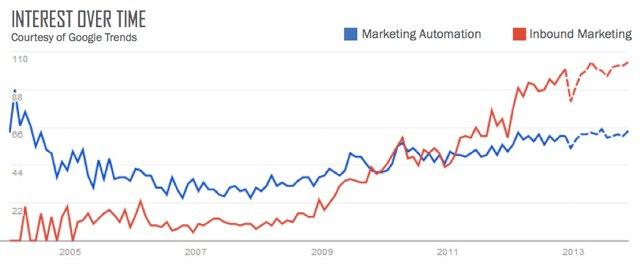 With the start of a new year lying ahead of us, holding new challenges in store for the digital marketing world, we‘d like to provide our readers with a summary of the 27 page Hubspot e-book: „20 Marketing Predictions for 2013 and Beyond“. So, get prepared!
With the start of a new year lying ahead of us, holding new challenges in store for the digital marketing world, we‘d like to provide our readers with a summary of the 27 page Hubspot e-book: „20 Marketing Predictions for 2013 and Beyond“. So, get prepared!

Prediction #1: Campaigns fade out & real-time marketing is in
The structure of campaigns is often times rigid and can’t keep up with changing customer behaviors and rapidly changing technology. Campaigns are generally short-lived and not triggered based upon real-time actions or data, which can put the marketer at a disadvantage. In 2013, buyers instantly engage with brands on their websites, talk back via social media like Twitter and Facebook, and follow breaking news in the markets they are interested in.” says David Meerman Scott, best-selling author.
Prediction #2: Inbound marketing grows enterprise-wide
In 2013, marketing will no longer sustain as its own department. Every interaction your sales, HR, customer, development, finance, and executive teams take online is a way to promote your brand, products, or services. As a result, almost every employee will turn into an inbound marketer.
Prediction #3: Know your customer
Smarter marketing means understanding your customers beyond demographic information. According to David Raab, contributing analyst at Gleanster, web behavior data as well as data from other sources, such as accounting or order processing systems, will become easier to integrate in 2013. Over the next year, it will become an increasingly important initiative for CMOs to invest in technology that compiles customer data in a way that is more easily measurable and actionable. As a result, customer analysis will become the hot new feature for marketing automation providers.
Prediction #4: Marketing becomes more accountable for revenue generation
A recent Fournaise Marketing Group study found that 73% of executives don’t believe that marketing drives demand and revenue. That will start to change. Marketing will play a more critical role in contributing to revenue generation. Marketing activities will not only be measured on traffic and lead generation, but will further optimize processes that directly impact sales growth. And to do that, key performance indicators (KPIs) under the marketing department will change.
Prediction #5: Social media gets integrated
Up until now, social media has remained very siloed. Activity that happens on social stays there. In the year ahead, integrating social media behavior and data into the rest of the marketing mix (and database) will become crucial in order to reach customers with relevant messages in real-time. Marketers will sync social media activity with their contact databases to have additional behavioral data to better segment email messages and calls-to-action. Additionally, marketers will leverage social media behavior for improved content personalization that will lead to better lead to customer conversion rates.
Prediction #6: Be mobile or fall behind
Clearly, mobile is where marketers need to be. According to an IBM study released in June 2012, almost 9 in 10 global marketers either have a mobile site or a mobile application, or plan to employ one in the future. However, only 1 in 5 currently runs mobile marketing tactics as part of integrated campaigns, with the remainder running their mobile programs discretely and on an ad hoc basis. In 2013, marketers will finally list mobile as a major line item on their marketing strategy. Not only will there be continued investment in mobile-optimized websites and email, but we’ll see mobile take a more important role when integrating with marketing campaigns.
Prediction #7: Social and content impact SEO even more
Over the years, good search engine optimization (SEO) was all about knowing the tricks of the trade. The SEO of tomorrow will be less about having the right H1 tag or the right keywords on the page and more about creating really good, original content that is socially consumed and shared.
“The overlap between search, social, and content will continue to increase at a rapid pace, spurred on by innovations from the search engines, and reinforced by the correlations of social sharing and linking/ranking behavior.” says Rand Fishkin, CEO of Seomoz, also stating that SEO will go further and further away from on-page SEO, and focus on the various components of off-page SEO.
Prediction #8: Companies look to hire more Inbound Marketing talent
Sure, marketers are great at creative, but the marketers that companies will hire in 2013 carry skills in content creation, lead generation, optimization and data analysis. With the growing importance of content and data, companies will simply hire more inbound marketers this year. According to trends measured by SimplyHired, “Inbound Marketing” jobs increased 52% and “Content Marketing” jobs increased 26% since October 2011.
Prediction #9: Big data gets bigger – and digestible
Gartner predicts that Big Data will drive $232 billion in IT spending through 2016. But so far, big data has been for engineers, not marketers. In 2013 we’ll see a rise of start-ups that are dedicated to making big data more accessible to folks on the front end, such as sales, business development, and marketing professionals.
Prediction #10: Marketers embrace “smart” content
The first time Amazon introduced people to the perfect book via their recommendation engine was impressive. Since then, data-driven personalization, or dynamic content, has become more common, though not entirely pervasive in the marketing space. In 2013, we’ll start to hear more about adaptive, ‘smart’ content. As context becomes increasingly important in any inbound marketing strategy, dynamic content enables marketers to serve highly personalize messages to the right audience at the right time.
Prediction #11: Marketing speaks like a human
No one likes marketing speak. That’s why we’ll start to see organizations become more “human” through social interactions and great content. Companies will develop a personality through storytelling, thus, corporations become less “faceless” and the trust between companies and consumers continues to grow.
Prediction #12: Email lives on
No, email is not dead. And it won’t be in 2013, either (as much as some of us would like it to). In fact, email will continue to be an important part of the marketing mix. However; how it will be used, is what will change. Marketing emails will become less “batch and blast” and instead more personalized, relevant and targeted, based on real-time data. There will be increased importance in opt-in marketing instead of opt-out marketing and buying lists will become a less-used practice.
Prediction #13: Inbound, not automation, becomes priority
Just a few years ago, marketing automation was the “must-have” on every marketer’s wish-list. Unfortunately, the “set-it and forget-it” mentality of automation, while nice sounding, resulted in an unhealthy process of churning a database of email through a set “nurturing” process until they were spammed to death. The promise of marketing automation starts to fail because it is not supported by a solid inbound marketing foundation. Essentially, not enough leads enter the funnel to keep the automated machine running. This is called “Death by Marketing Automation.” in 2013. CMOs and senior executives will allocate more resources to creating a strong inbound engine - generating interest, traffic, leads, and conversions - to support the demand generation engine.
Prediction #14: Marketing technology evolves
In 2012, we saw a lot of acquisitions, IPOs, private rounds of funding, and the emergence of new start-ups. As the marketing industry heats up, we can expect even more action. This is great news for the marketing industry. In 2013, we will see two major changes in the technology landscape:
- More investment in technology solutions that solve for inbound marketing, social media management, and marketing measurement, attribution and ROI. More importantly, software and services that are integrated and unified with other channels, departments, and databases are key.
- As more widgets, gadgets and devices enter the market, marketers will need to figure out how to use each platform in the best and most appropriate way.
Prediction #15: I’ll take some content curation, please
Content is king, whether you like it or not. Creating more and more content will be among the top priorities for marketing teams in 2013. In addition to the increase in allocating budget to content creation, we’ll find increasingly more curation services, services that preserve and maintain digital assets, as well as “content marketplaces” that will help marketers deliver more in a content-heavy world.
Prediction #16: Content crowdsourcing grows
Socially-generated content, where an audience builds content (usually through a contest), has been done for years, but there is an even bigger opportunity for crowdsourcing platforms that contribute to new marketing ideas. As the social footprint grows, marketers will find more ways to leverage crowd creativity by building interesting and viral pieces of content with their network of fans and followers.
Prediction #17: Marketing gets gamified
Expect to see the convergence of marketing and gaming over the next year. And we don’t mean product placement in Farmville. Marketing will become more interactive in how it’s deployed and consumed. “Gamificiation” will help increase the stickiness of content through its entertainment value, reward, and learning abilities. Perhaps through gamification, marketing will actually be enjoyable instead of avoided.
Prediction #18: A picture is worth 1000 words
With all this attention toward content as the holy grail of marketing, it doesn’t mean that written content is the only form that works. Sites like Pinterest and Instragram prove that visual content is really worth 1000 words. Infographics, photos, picture boards, video, and other forms of rich-media will increase over the coming years as humans look to digest more information faster than ever before.
Prediction #19: Context is content’s new best friend
To do marketing better in 2013, marketers will need to go beyond simply creating content to creating a personalized experience for their target customer that’s seamless across multiple interactions. These experiences will leverage context to make a company’s marketing jive with the searcher’s proclivities – the things you’ve learned about your leads over months and years of talking with them.
Prediction #20: Outbound marketing loses traction
Mass marketing gets a 2% response rate, if you’re lucky. Inbound marketing, on the other hand, can produce conversion rates 10x higher or more. That’s because prospects respond to valuable content that is more helpful and educational. More so than ever before, budgets spent on outbound marketing (paid media) will shift to inbound marketing (earned media and original content). (Source: hubspot.com)
By Hiba Assi


